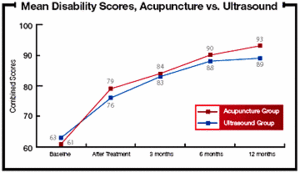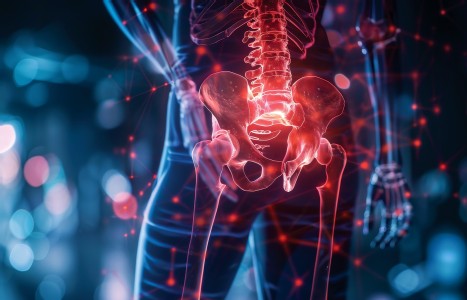Pelvic pain has a prevalence of >25% in women and >15% in men, and up to 50% of cases are undiagnosed, demonstrating that there is a definite need for pelvic care awareness among health care practitioners. As holistic practitioners, acupuncturists offer a safe space for clients and are often the practitioners clients seek out when nothing else has worked. Thus, acupuncturists are presented with an opportunity to serve an underserved population.
Study: Acupuncture Superior to Ultrasound for Shoulder Impingement
Impingement syndrome is one of the most common diagnoses among people with shoulder problems. It affects the rotator cuff, a group of muscles and tendons that secure the arm to the shoulder joint and allow the arm to rotate. People diagnosed with impingement syndrome usually experience pain in the area of the deltoid muscles, especially when trying to elevate their arm; the pain may extend from the top of the shoulder as far down as the elbow.
The condition occurs most often in athletes whose activity requires repeated overhead arm movements (such as tennis, swimming or golf), and in people whose jobs required repetitive overhead lifting.One of the most common treatments for impingement syndrome is ultrasound, which is believed to stimulate the tissues surrounding the rotator cuff and improve blood flow in the area. In the mid-1990s, however, two systematic reviews of therapeutic ultrasound - one published in Physiotherapy Theory and Practice,1 the other in Pain2 - cast aspersions on its effectiveness in the treatment of soft-tissue injuries and musculoskeletal disorders.

Another common intervention for impingement syndrome is acupuncture, which also helps increase blood flow and may help injured muscles heal more quickly. In a recent issue of the scientific journal Physical Therapy,3 researchers in Sweden compared the use of ultrasound to acupuncture in treating shoulder impingement, with both therapies used in conjunction with a home exercise program. The results of the study showed that while patients in both groups improved, patients who received acupuncture reported greater improvement than ultrasound patients, suggesting that acupuncture is "more efficacious," especially when applied along with home exercises.
In the study, 85 adults (ages 30 to 65) diagnosed with impingement syndrome of at least two months' duration were randomly assigned to receive acupuncture or ultrasound. Patients in the acupuncture group received 10 treatment sessions over a five-week period, with needles inserted into four local points (LI 14, LI 15, LU 1 and TE 14) and one distal point (LI 4). Subjects were asked to lie on a treatment table on their unaffected side; after the needles were inserted, they were manipulated until de qi was experienced. Manipulations were performed upon the original needle insertion, and again at 15 minutes and 30 minutes, so that a total of three de qi sensations were experienced at each point per session. Each acupuncture session lasted 30 minutes, and was repeated twice per week for five weeks.
In the ultrasound group, patients received continuous ultrasound twice per week for five weeks. Each session lasted 10 minutes, with an ultrasound device used to treat an area of skin approximately 100 square centimeters in size, just below the anterior and lateral part of the acromion. Small circular motions were used to treat the area thoroughly.
In addition to receiving ultrasound or acupuncture, patients in both groups participated in a two-step home exercise program. The first part of the program consisted of low-intensity exercises targeted to maintain or restore motion and to stimulate circulation in the rotator cuff; in the second part, patients performed exercises aimed at strengthening rotator cuff muscles. Adherence to the program was documented using a home exercise diary.
To measure the effectiveness of each therapy, scientists used three disease-specific shoulder assessment tests, including one test designed specifically for patients with impingement syndrome. Tests were administered the week after the treatment period was completed, and at three months, six months and 12 months from the date of the initial patient visit. Because the tests measured the effectiveness of care using different scales, they were recalibrated and combined into one mean disability score.
Analysis of the disability scores found that while subjects in both groups improved over time, patients who received acupuncture showed more rapid improvement than those who received ultrasound. Average disability scores for acupuncture patients also were consistently higher than ultrasound patients. According to the authors, "The between-group analysis, including the mean scores from all four assessment visits (after five weeks of acupuncture or ultrasound and at three, six and 12 months), showed a larger change in the combined score for the acupuncture group, analyzed with those adhering to the study protocol. This effect was seen already at the first assessment visit and was maintained over time."

Some limitations in study design were reported, most notably with regard to the different disability tests used to measure the effectiveness of care. Because the properties of the exams varied, the authors admitted to selecting the mean of the exams' total scores "mainly to make the reporting of results less complicated." In addition, while all of the exams measured physical signs and symptoms of shoulder disability, no tests were performed to determine the psychological effects of treatment; thus, according to the researchers, "the influence of psychosocial factors is unknown."
Despite these shortcomings, the scientists remained confident in their assertion that acupuncture, in combination with a home exercise program, provided a greater benefit for people with shoulder impingement than a combination of exercises and ultrasound. As they noted in their conclusion:
"To our knowledge, this is the first randomized clinical trial involving patients with impingement syndrome and comparing acupuncture and ultrasound, both combined with a home exercise program. The larger improvement in the acupuncture group, which was seen at the first assessment visit and maintained over time, indicates that a physical therapy strategy with a combination of acupuncture and home exercises is more beneficial for most patients with impingement syndrome. In conclusion, acupuncture is advocated before ultrasound, in addition to home exercises, for patients with impingement syndrome."
References
- Holmes MAM, Rudland JR. Clinical trials of ultrasound treatment in soft tissue injury: a review and critique. Physiotherapy Theory and Practice 1991;7:163-175.
- Nyholm Gam A, Johannsen F. Ultrasound therapy in musculoskeletal disorders: a meta-analysis. Pain 1995;63:85-91.
- Johansson KM, Adolfsson L, Foldevi MOM. Effects of acupuncture versus ultrasound in patients with impingement syndrome: randomized clinical trial. Physical Therapy 2005;85(6):490-501.



